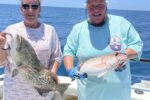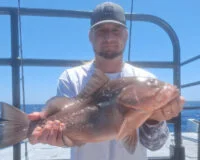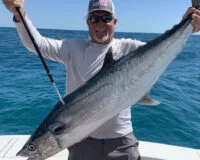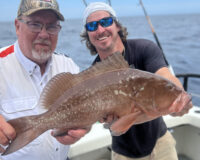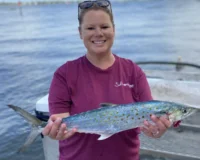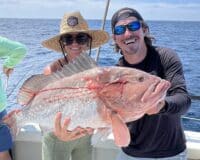Hubbard's Marina Fishing Report
Inshore Fishing Report
We had high hopes we were nearly done with the red tide around the area, but we are still seeing lingering areas of the bloom present and some areas forecasting some increases. However, overall, still much improved over where we were a few weeks ago. Plus, we have seen and heard a great improvement in feeding fish around the area. Seems the bay and intercostal waterways are coming back strong behind the recent bloom. Keep an eye on the forecasts and reports via this link if you are interested -> http://ocgweb.marine.usf.edu/tbm/hab/
Snook are building up back into the passes almost like they are restarting their staging for their summertime spawn. Through the week we saw extremely clear waters in the passes and then towards the second half of the week waters were still clear, but they got darker with more and more freshwater pouring out of the back bays from the recent rains. Sometimes resembling more of the river water look than our salty gulf waters. However, on a big incoming towards the end of the tide the water clears up considerably as the brackish low salinity water pushes back into the bay. We are seeing the snook feeding well when the water is moving especially in the early morning prior to and around sunrise or around sunset outside of the heat of the day. Those afternoon storms help to cool things off quick and if they happen early enough fishing the backside of the storms has produced nice catches of fish. During the heat of the day, target these guys around the bridges, docks, or under the shade of the mangrove shoreline. They are more sluggish and less active when the water is hot and nearly inactive when the water is stagnant and not moving around.
Redfish action has really been positive around the area lately with some nice schools of fish foraging around the flats and oyster bars. Plus, we are seeing some nice redfish numbers around the schools of mullet moving around the flats too. Typically, they are moving through shallower waters working the edges and or hanging in the deeper holes. Like the snook, they are looking for cooler areas and are most active and feeding best early in the morning or later in the day. Cut bait is a great option during the warmer part of the day while in the low light conditions in the morning and around dusk soft plastics and even surface lures are good options.
Trout are biting too throughout the area but are hanging on those deeper flats and around those edges where they can find a deeper spot to sit and wait for bait to come to them. Trout love slower moving soft plastics, live shrimp, white bait, or small pinfish. Use lighter tackle and slow action rods to try for those trout.
Tarpon action still going well through the area and were even seeing them come back to some of the passes they disappeared from due to the recent bloom. Look for them at night around the lights of the bridges where water is moving. Also, during the day they can be found cruising the beaches. The swash channels around Fort De Soto and Egmont key are great areas that typically present a great opportunity to hook a tarpon. However, the tides were a little weak this past week while this upcoming week we have more dramatic tides that will help inspire more tarpon action for sure.
Mangrove snapper are really prolific feeding well through the area. Look for them around virtually any structures using ultra light tackle and a jig head or a smaller hook with minimal weight. Fishing deeper structures of Tampa Bay produce bigger mangrove snapper but you must hit them at the right time where water is moving more slowly. Great way to plan your trip is to make sure you’re on the flats, mangroves, or dock lines when water is moving and when tides are slowing before they change you can move over to the mangrove fishing on structures in deeper waters. Around 15-20lb leader and about a number one to one ot hook is a great way to tackle up for the mangrove snapper with a smaller shrimp or chunk of larger shrimp.
Nearshore Fishing Report
We have had the hogfish bite remain somewhat steady through the area. Much better than it has been through the beginning of the summer but were going on a special hogfish hunt ahead of this storm that we are hoping produces a great catch. They are hanging around 40-60ft of water primarily, but we have seen them as deep as around 90ft of water too. They are little more difficult to target as you move deeper where more aggressive prolific fish are present. Shallower, it seems to be a bit easier to get the hogfish to bite for us and cooperate using light tackle and live shrimp on a jig head, nekid ball jig or a knocker rig set up. Around 30lb leader, 3-4ot hook, and a live shrimp is the best bet for some hogfish action plus plenty of lane snapper, mangroves and plentiful grey snapper or white grunts.
The red grouper action is also steady, nothing to write home about currently but great to see them present and biting again more dependably. They are more common and aggressive towards the deeper near shore waters around 70-100ft of water. Using larger strips of squid, bonita strips, live pinfish or whole threadfins are the best option to target the red grouper.
Gag grouper aren’t too prolific near shore, but we are seeing a few. Typically, smaller boats with less leads going to bottom that can fish those smaller more strategic ledges are a great way to get some keeper sized gags without running deep. However, when the water is this warm and only getting warmer primarily the bigger concentrations of gag grouper are much deeper beyond the near shore waters. Use the bigger live baits for the best options for gag grouper. Also, trolling shallower and around the deepest parts of the Egmont channel edges are producing the keeper gag grouper. Trolling large diving plugs are best bet, but some will use the bucktails with a soft plastic behind a planner with success too. Using around 65lb braid and around 50-60lb leaders are the typical gag grouper trolling set up on very large spinners or lighter conventionals. The benefit of the trolling method is typically since the boat is moving around 5-7 knots the grouper don’t have a chance to rock you up as your inertia will pull that fish away from his rocky home where he could possibly break you off when hooked.
Lane snapper are fairly thick near shore around 60-90ft of water using lighter tackle and a small cube of squid is a great method to harvesting some plentiful great eating lane snapper. However, we see them as shallow as 40ft of water and we also catch them using small chunks of threadfin or live shrimp too.
Mangrove snapper are steady near shore, not in huge numbers and not super concentrated but you can get some decent catches if you focus on them with specialty tackle and an experienced approach. Using that double snell rig with a chunk of threadfin or live shrimp on that hogfish set up is a great way to nab a nice mangrove snapper near shore.
Offshore Fishing Report
We are looking forward to fishing the backside of this storm hoping that the fish will be hungry on the first quarter moon phase after not feeding for a few days as well. Should all add up for a great push of fish at the start of next week. This will also stir things up offshore and get waters moving and get them a little more excited with cooler surface temps from added rain which could get pelagic action going more as well. Typically, we will see some unique currents and possible even upwellings created behind these storms that will attract pelagics from around the area, especially if Fred is strengthening as it passes.
Currently, we are seeing a much better than expected amberjack bite and we really did well last weekend on our 39 hour hunting these larger fish. We were hoping to be targeting them again this weekend but fred had other plans. We are seeing these large jacks out there past around 140ft of water or more on the big structures like big peaks, ledges, wrecks and springs. The largest possible live bait is always a great bet for jacks, but you can catch them on big dead baits and also vertical jigs. Big tackle, big bait and big patience will net you the biggest Jacks. 80-100lb line is minimal for Amberjack fishing with a very large hook to match the size of your bait. Using heavier lead is also important if you have larger live baits. If you can get away with it and you have the room around you a longer leader gives that live bait more travel area and typically a better more natural presentation. I like to drop it down just out of sight, then stop the reel and slowly drop the bait from there and if you feel it start to get excited and really moving around stop the reel again while keeping it in freespool and wait a minute. Often, you will get hit before ever reaching bottom meaning you don’t have to fight the fish as far. Plus, dropping the live bait like this ensures that it’s the most lively as it can be. If you let him rocket to bottom often times they can die or get very lethargic at the extreme pressure change in such a short time.
Gag grouper fishing has slacked a bit, but we are still seeing a few fish in the 15-25lb range come up. The largest challenge is just getting them up off the bottom with the right tackle and a lot of luck with a little experience. You have to have a conventional reel with some power and at least 80-100lb test and if you’re out deeper than 140-160 at least 80-100lb maybe even 125lb leader trying to land that 20-25lb gag grouper. Live bait has been a great option for the gag grouper as well, but you can get them on the big chunks of bonita or whole octopus or squid too from time to time.
Red grouper fishing has been steady offshore with some really big fat red grouper coming up from those deepwater potholes and hardbottom areas with a big bait show. We are seeing nice vermillion and porgies mixed into these bait laiden areas of hard bottom as well. Great way to target red grouper is with the whole squid or squid strips or octopus tentacles.
Scamp grouper are biting out there in the deeper offshore waters while targeting the gags, red grouper and jacks beyond 120ft you start to see them more but once closer to 200ft is where you see the monsters. Smaller to medium pinfish are a great way to go after scamp with 60-80lb test. Also, a smaller 4-6oz hammered diamond jig at the start or end of a fishing spot is a great method too bounced just on or above the bottom. We catch most of our scamp grouper while targeting mangrove snapper with that double snell rig and a chunk of threadfin.
Mangrove snapper action has been steady, but not crazy as of late. We are seeing good numbers of yellowtail and big vermillion and plenty of porgies mixed in depending on the area fished. Lighter tackle around 40-60lb leader and a double snell rig with the cut chunk of threadfin, sardine or cigar minnow is the best way to target mangrove snapper.
Mahi Mahi are around through the deepest near shore water extending offshore through the range. We are seeing schools of chicken dolphin envelope our offshore boats from time to time and using a casting spoon, yellow bucktail or my favorite, a Gotcha plug is a great way to sight cast to these fast moving schools. However, you can even free line a chunk of threadfin or shrimp sometime and get one to bite.
Kingfish are around out there and were seeing them trolling, flat lining and sometimes even knocker rigging. Tuna are being caught from time to time but not super dependable. Wahoo are around and always possible, but one of those rarities and you have to be ready if they swim by with a stinger rig ready to deploy.

